Influence of Nano Silica Particles on Durability of Flax Fabric Reinforced Geopolymer Composites
Abstract
1. Introduction
2. Materials and Methods
2.1. Materials and Sample Preparation
2.2. Characterisation
2.3. Physical and Mechanical Properties
3. Results
3.1. Physical Properties
3.2. Characterisation and Microstructure
3.3. Flexural Properties of Geopolymer Nanocomposites
3.4. Flexural Properties of Flax Fabric Reinforced Geopolymer Nanocomposites
4. Conclusions
- Nanosilica effects on the durability of flax fabric reinforced geopolymer composites with nanosilica were established and the optimum content of nanosilica were reported.
- The physical and mechanical properties of FF-geopolymer nanocomposites subjected to long period of curing were also evaluated.
- NS was found to decrease the internal voids and densify the microstructure of geopolymer nanocomposites due to its low specific weight as compared to fly ash.
- The test results indicated a 23.01% reduction in the flexural strengths of GP/FF composites without NS after 32 weeks, while the GPNS-1/FF composites with NS experienced a 10.2% decrease in flexural strength subjected to the same period of curing.
- SEM analysis shows that the nanoparticle fills the void spaces, which result in uniform, less voids and compact geopolymer matrix.
- Based on SEM images, it was observed that the degradation of flax fabric reinforced geopolymer composites without nanosilica was higher than that with 1.0 wt.% nanosilca.
- The FTIR spectra and XRD analysis of geopolymer composites with nanoslica demonstrated that the additions of nanosilica promote the geopolymerisation reaction, thus creating a higher amount of amorphous geopolymeric gel within the matrices. This, in turn, show that nanoparticles assist in preventing the strength retrogression of geopolymer nanocomposites.
Author Contributions
Funding
Acknowledgments
Conflicts of Interest
References
- Davidovits, J. Geopolymers—Inorganic polymeric new materials. J. Therm. Anal. 1991, 37, 1633–1656. [Google Scholar] [CrossRef]
- Duxson, P.; Fernández-Jiménez, A.; Provis, J.L.; Lukey, G.C.; Palomo, A.; Deventer, J.S.J. Geopolymer technology: The current state of the art. J. Mater. Sci. 2007, 42, 2917–2933. [Google Scholar] [CrossRef]
- Lin, T.; Jia, D.; He, P.; Wang, M.; Liang, D. Effects of fibre length on mechanical properties and fracture behavior of short carbon fibre reinforced geopolymer matrix composites. Mater. Sci. Eng. A 2008, 497, 181–185. [Google Scholar] [CrossRef]
- Alomayri, T.; Shaikh, F.U.A.; Low, I.M. Synthesis and mechanical properties of cotton fabric reinforced geopolymer composites. Compos. Part B: Eng. 2014, 60, 36–42. [Google Scholar] [CrossRef]
- Herrera-Franco, P.J.; Valadez-González, A. A study of the mechanical properties of short natural-fibre reinforced composites. Compos. Part B: Eng. 2005, 36, 597–608. [Google Scholar] [CrossRef]
- Bohlooli, H.; Nazari, A.; Khalaj, G.; Kaykha, M.M.; Riahi, S. Experimental investigations and fuzzy logic modeling of compressive strength of geopolymers with seeded fly ash and rice husk bark ash. Compos. Part B 2012, 43, 1293–1301. [Google Scholar] [CrossRef]
- Alomayri, T.; Shaikh, F.U.A.; Low, I.M. Characterisation of cotton fibre-reinforced geopolymer composites. Compos. Part B 2013, 50, 1–6. [Google Scholar] [CrossRef]
- Alomayri, T.; Shaikh, F.U.A.; Low, I.M. Thermal and mechanical properties of cotton fabric-reinforced geopolymer composites. J. Mater. Sci. 2013, 48, 6746–6752. [Google Scholar] [CrossRef]
- Alzeer, M.; MacKenzie, K. Synthesis and mechanical properties of novel composites of inorganic polymers (geopolymers) with unidirectional natural flax fibres (phormium tenax). Appl. Clay Sci. 2013, 75–76, 148–152. [Google Scholar] [CrossRef]
- Alzeer, M.; MacKenzie, K.D. Synthesis and mechanical properties of new fibre-reinforced composites of inorganic polymers with natural wool fibres. J. Mater. Sci. 2012, 47, 6958–6965. [Google Scholar] [CrossRef]
- Assaedi, H.; Alomayri, T.; Shaikh, F.U.A.; Low, I.-M. Characterisation of mechanical and thermal properties in flax fabric reinforced geopolymer composites. J. Adv. Ceram. 2015, 4, 272–281. [Google Scholar] [CrossRef]
- Hakamy, A.; Shaikh, F.U.A.; Low, I.M. Effect of calcined nanoclay on the durability of NaOH treated hemp fabric-reinforced cement nanocomposites. Mater. Des. 2016, 92, 659–666. [Google Scholar] [CrossRef]
- Aly, M.; Hashmi, M.S.J.; Olabi, A.G.; Messeiry, M.; Hussain, A.I.; Abadir, E.F. Effect of nano-clay and waste glass powder on the properties of flax fibre reinforced mortar. J. Eng. Appl. Sci. 2011, 6, 19–28. [Google Scholar]
- Yan, L.; Chouw, N. Effect of water, seawater and alkaline solution ageing on mechanical properties of flax fabric/epoxy composites used for civil engineering applications. Constr. Build. Mater. 2015, 99, 118–127. [Google Scholar] [CrossRef]
- Gram, H.-E. Methods for reducing the tendency towards embrittlement in sisal fibre concrete. Nordic Concr. Res. 1983, 5, 62–71. [Google Scholar]
- Velpari, V.; Ramachandran, B.E.; Bhaskaran, T.A.; Pai, B.C.; Balasubramanian, N. Alkali resistance of fibres in cement. J. Mater. Sci. 1980, 15, 1579–1584. [Google Scholar] [CrossRef]
- Assaedi, H.; Shaikh, F.U.A.; Low, I.M. Effect of nanoclay on durability and mechanical properties of flax fabric reinforced geopolymer composites. J. Asian Ceram. Soc. 2017, 5, 62–70. [Google Scholar] [CrossRef]
- Rickard, W.D.A.; Williams, R.; Temuujin, J.; van Riessen, A. Assessing the suitability of three Australian fly ashes as an aluminosilicate source for geopolymers in high temperature applications. Mater. Sci. Eng.: A 2011, 528, 3390–3397. [Google Scholar] [CrossRef]
- Chen-tan, N.W.; Van Riessen, A.; Ly, C.V.; Southam, D.C. Determining the Reactivity of a Fly Ash for Production of Geopolymer. J. Am. Ceram. Soc. 2009, 92, 881–887. [Google Scholar] [CrossRef]
- Standard Test Methods for Apparent Porosity, Water Absorption, Apparent Specific Gravity, and Bulk Density of Burned Refractory Brick and Shapes by Boiling Water1. 2010. Available online: https://www.astm.org/DATABASE.CART/HISTORICAL/C20-00R10.htm (accessed on 6 May 2019).
- Low, I.M.; McGrath, M.; Lawrence, D.; Schmidt, P.; Lane, J.; Latella, B.A.; Sim, K.S. Mechanical and fracture properties of cellulose-fibre-reinforced epoxy laminates. Compos. Part A: Appl. Sci. Manuf. 2007, 38, 963–974. [Google Scholar] [CrossRef]
- Phoo-ngernkham, T.; Chindaprasirt, P.; Sata, V.; Hanjitsuwan, S.; Hatanaka, S. The effect of adding nano-SiO2 and nano-Al2O3 on properties of high calcium fly ash geopolymer cured at ambient temperature. Mater. Des. 2014, 55, 58–65. [Google Scholar] [CrossRef]
- Supit, S.W.M.; Shaikh, F.U.A. Durability properties of high-volume fly ash concrete containing nano-silica. Mater. Struct. 2014, 48, 2431–2445. [Google Scholar] [CrossRef]
- Hakamy, A.; Shaikh, F.U.A.; Low, I.M. Characteristics of nanoclay and calcined nanoclay-cement nanocomposites. Compos. Part B: Eng. 2015, 78, 174–184. [Google Scholar] [CrossRef]
- Assaedi, H.; Shaikh, F.U.A.; Low, I.M. Influence of mixing methods of nano silica on the microstructural and mechanical properties of flax fabric reinforced geopolymer composites. Constr. Build. Mater. 2016, 123, 541–552. [Google Scholar] [CrossRef]
- Assaedi, H.; Shaikh, F.U.A.; Low, I.M. Characterizations of flax fabric reinforced nanoclay-geopolymer composites. Compos. Part B: Eng. 2016, 95, 412–422. [Google Scholar] [CrossRef]
- Zaharaki, D.; Komnitsas, K.; Perdikatsis, V. Use of analytical techniques for identification of inorganic polymer gel composition. J. Mater. Sci. 2010, 45, 2715–2724. [Google Scholar] [CrossRef]
- Nazari, A.; Sanjayan, J.G. Hybrid effects of alumina and silica nanoparticles on water absorption of geopolymers: Application of Taguchi approach. Measurement 2015, 60, 240–246. [Google Scholar] [CrossRef]
- Deer, W.A.; Howie, R.A.; Zussman, J. An introduction to the rock-forming minerals, 2nd ed.; Pearson: Essex, England, 1996. [Google Scholar]
- Schneider, H.; Schreuer, J.; Hildmann, B. Structure and properties of mullite—A review. J. Eur. Ceram. Soc. 2008, 28, 329–344. [Google Scholar] [CrossRef]
- Phair, J.W.; Van Deventer, J.S.J. Effect of the silicate activator pH on the microstructural characteristics of waste-based geopolymers. Intern. J. Miner. Proces. 2002, 66, 121–143. [Google Scholar] [CrossRef]
- Li, Q.; Xu, H.; Li, F.; Li, P.; Shen, L.; Zhai, J. Synthesis of geopolymer composites from blends of CFBC fly and bottom ashes. Fuel 2012, 97, 366–372. [Google Scholar] [CrossRef]
- Chindaprasirt, P.; Jaturapitakkul, C.; Chalee, W.; Rattanasak, U. Comparative study on the characteristics of fly ash and bottom ash geopolymers. Waste Manag. 2009, 29, 539–543. [Google Scholar] [CrossRef]
- Rattanasak, U.; Chindaprasirt, P. Influence of NaOH solution on the synthesis of fly ash geopolymer. Miner. Eng. 2009, 22, 1073–1078. [Google Scholar] [CrossRef]
- ul Haq, E.; Kunjalukkal Padmanabhan, S.; Licciulli, A. Synthesis and characteristics of fly ash and bottom ash based geopolymers–A comparative study. Ceram. Intern. 2014, 40, 2965–2971. [Google Scholar] [CrossRef]
- Liew, Y.-M.; Heah, C.-Y.; Mohd Mustafa, A.B.; Kamarudin, H. Structure and properties of clay-based geopolymer cements: A review. Prog. Mater. Sci. 2016, 83, 595–629. [Google Scholar] [CrossRef]
- Assaedi, H.; Shaikh, F.U.A.; Low, I.M. Effect of nano-clay on mechanical and thermal properties of geopolymer. J. Asian Ceram. Soc. 2015, 4, 19–28. [Google Scholar] [CrossRef]
- Yadollahi, M.M.; Benli, A.; Demirboğa, R. The effects of silica modulus and aging on compressive strength of pumice-based geopolymer composites. Constr. Build. Mater. 2015, 94, 767–774. [Google Scholar] [CrossRef]
- Zhang, Y.J.; Wang, Y.C.; Xu, D.L.; Li, S. Mechanical performance and hydration mechanism of geopolymer composite reinforced by resin. Mater. Sci. Eng.: A 2010, 527, 6574–6580. [Google Scholar] [CrossRef]
- Rong, Z.; Sun, W.; Xiao, H.; Jiang, G. Effects of nano-SiO2 particles on the mechanical and microstructural properties of ultra-high performance cementitious composites. Cem. Concr. Compos. 2015, 56, 25–31. [Google Scholar] [CrossRef]
- Mohamed, A.M. Influence of nano materials on flexural behavior and compressive strength of concrete. HBRC J. 2016, 12, 212–225. [Google Scholar] [CrossRef]
- Abanilla, M.A.; Karbhari, V.M.; Li, Y. Interlaminar and intralaminar durability characterization of wet layup carbon/epoxy used in external strengthening. Compos. Part B: Eng. 2006, 37, 650–661. [Google Scholar] [CrossRef]
- Bentur, A.; Mindess, S. Fibre Reinforced Cementitious Composites, 2nd ed.; Taylor & Francis: New York, NY, USA, 2007; pp. 456–458. [Google Scholar]
- Pacheco-Torgal, F.; Jalali, S. Cementitious building materials reinforced with vegetable fibres: A review. Constr. Build. Mater. 2011, 25, 575–581. [Google Scholar] [CrossRef]
- Mohr, B.J.; Biernacki, J.J.; Kurtis, K.E. Supplementary cementitious materials for mitigating degradation of kraft pulp fibre-cement composites. Cem. Concr. Res. 2007, 37, 1531–1543. [Google Scholar] [CrossRef]
- Filho, J.O.D.; Silva, D.A.; Toledo, R.D. Degradation kinetics and aging mechanisms on sisal fibre cement composite systems. Cem. Concr. Compos. 2013, 40, 30–39. [Google Scholar] [CrossRef]
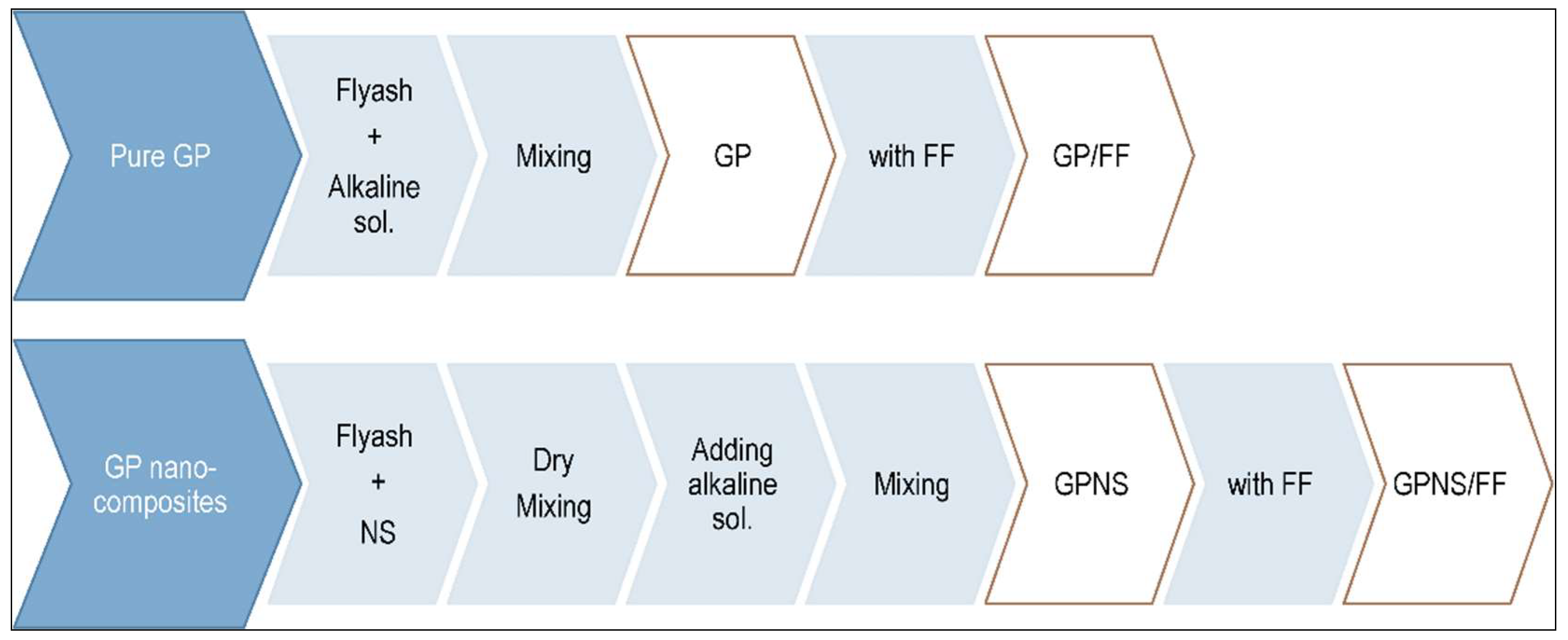
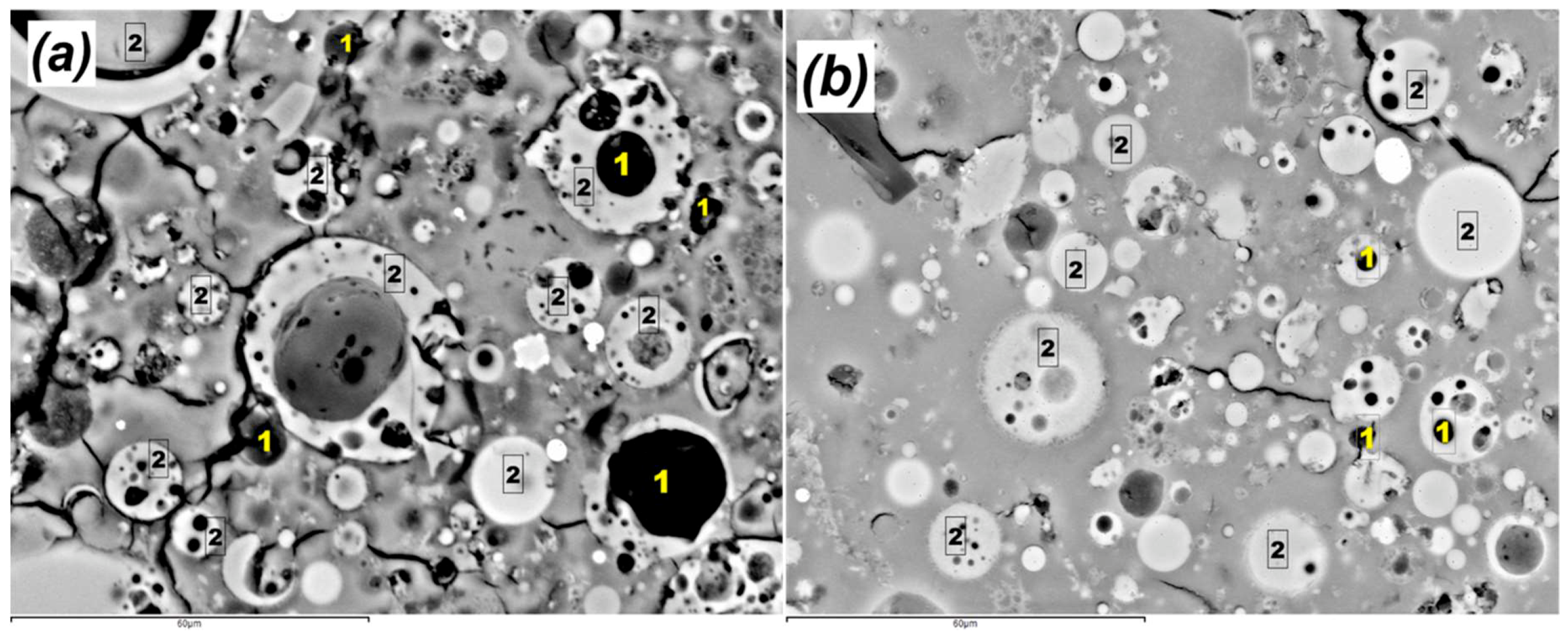
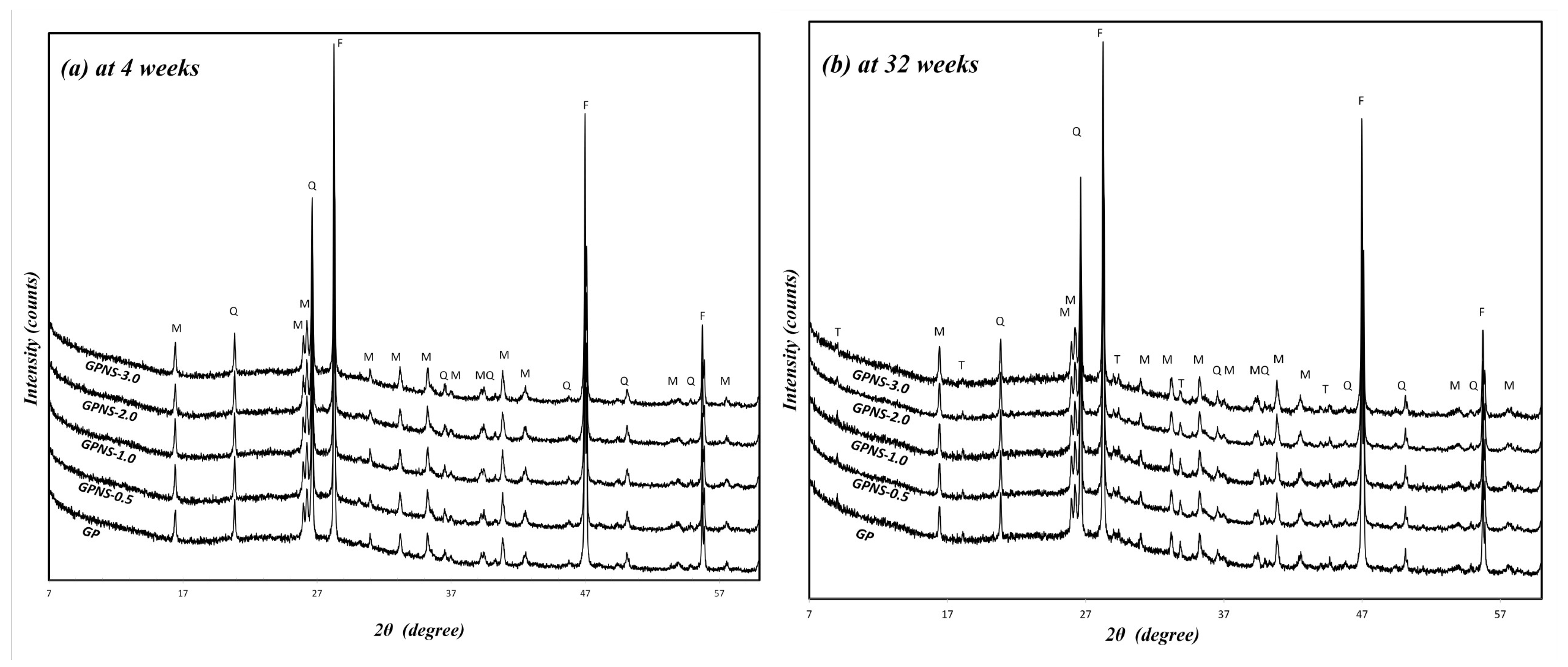
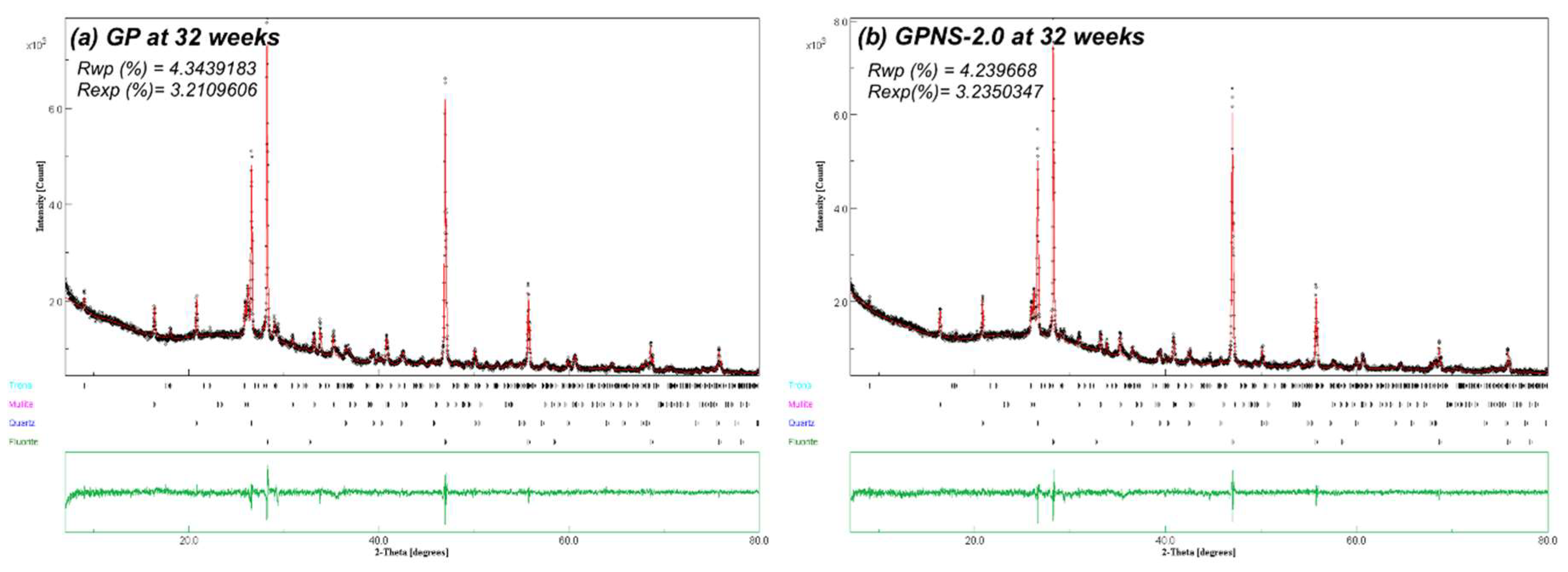

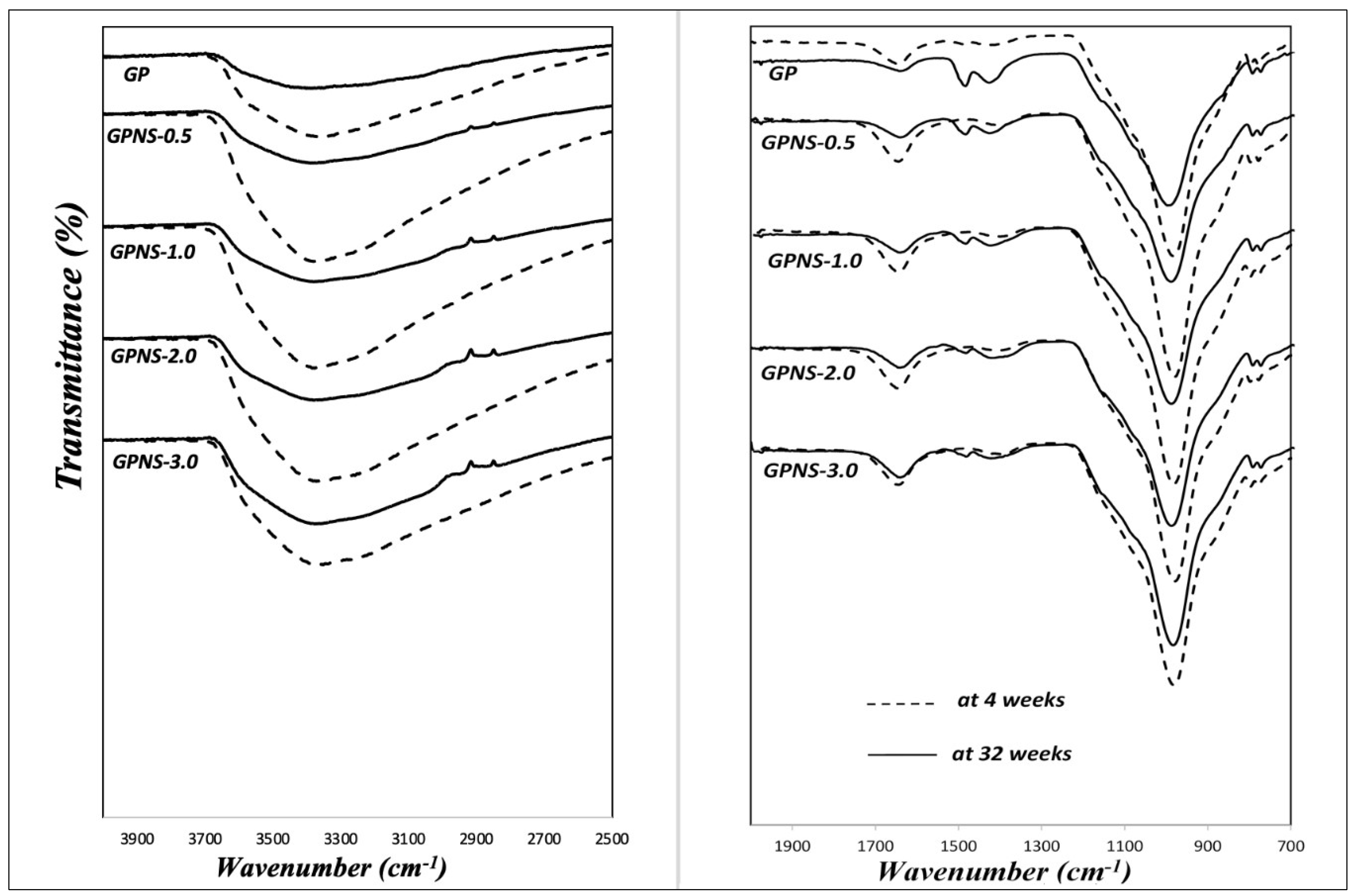


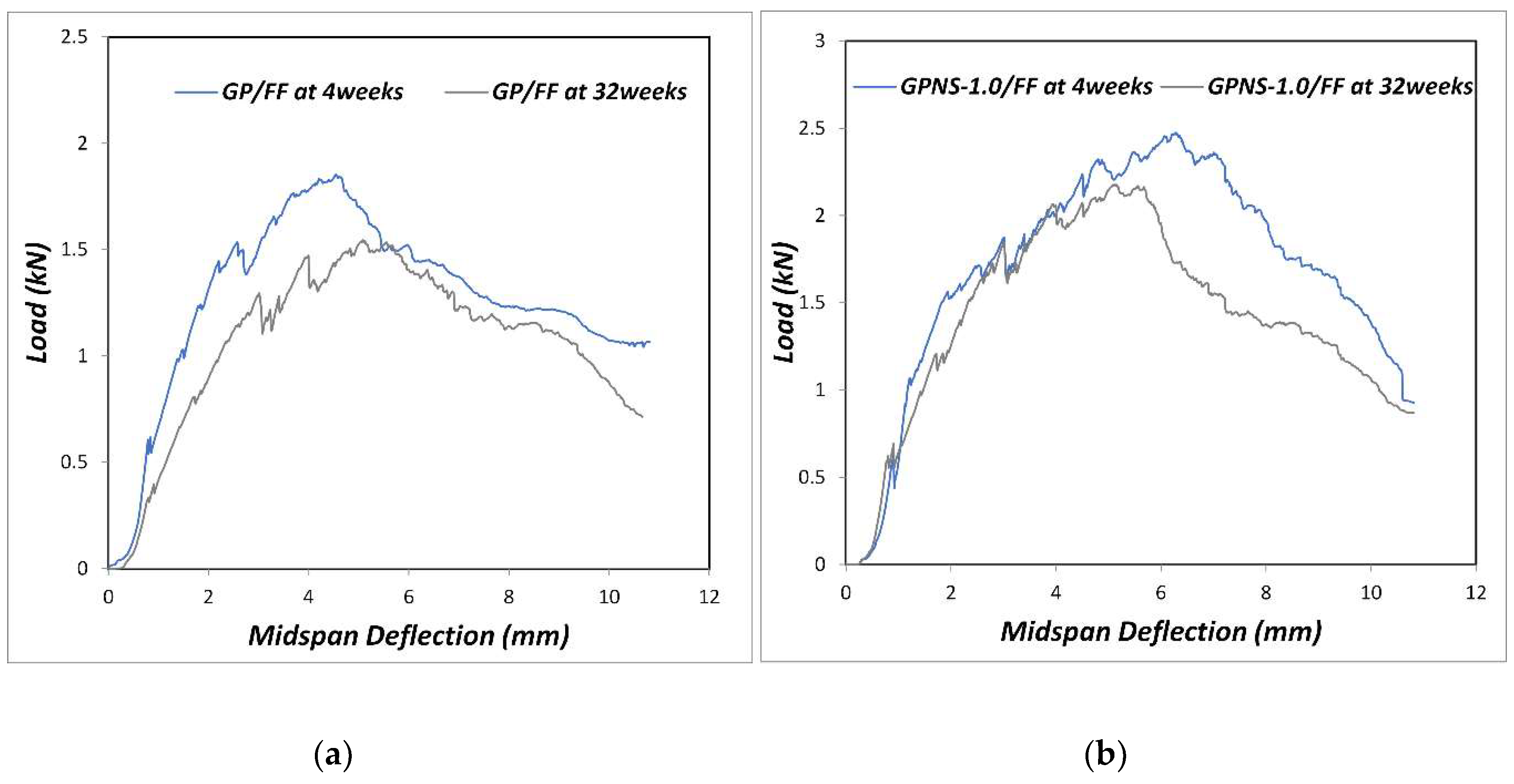
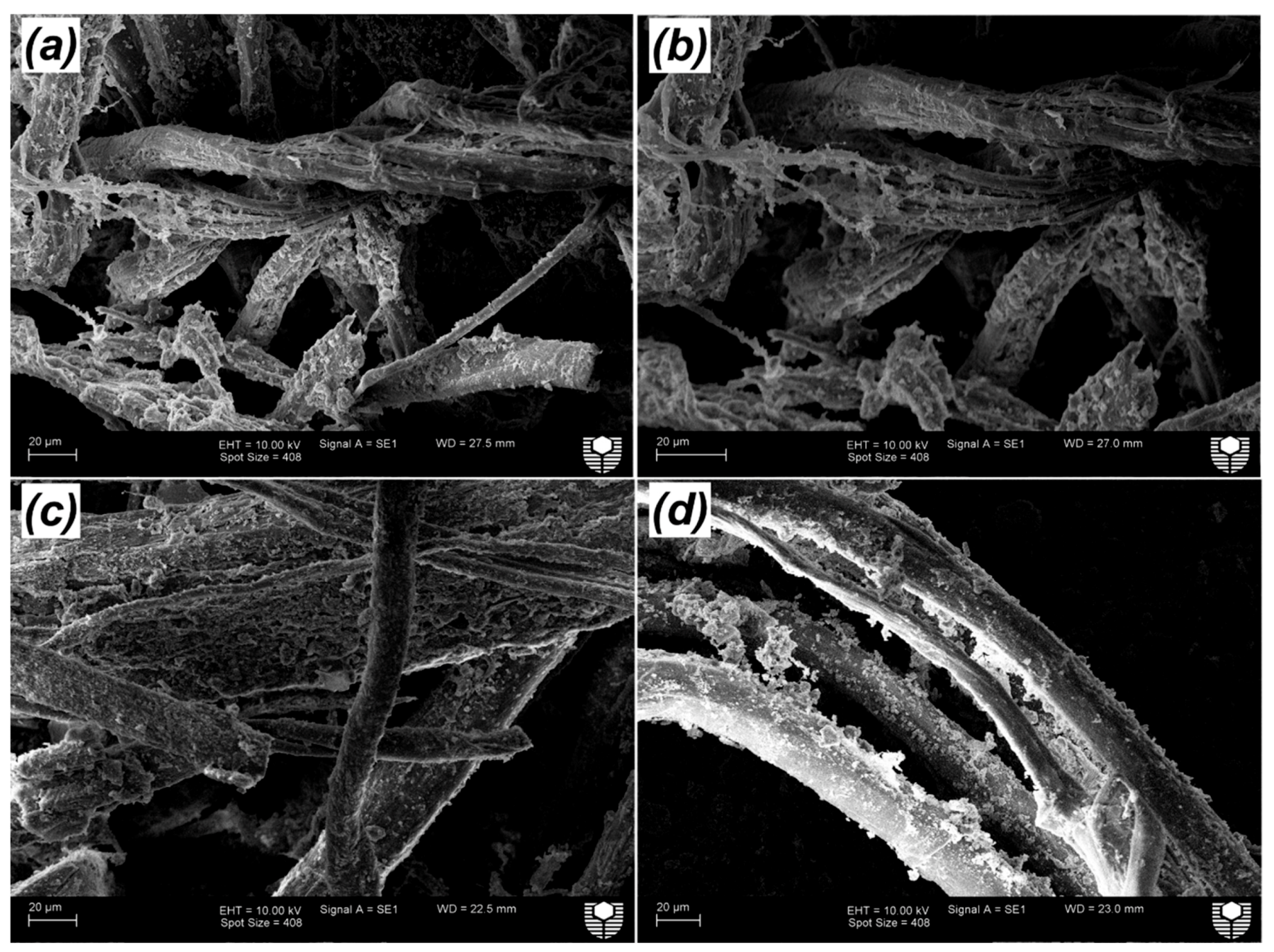
| Sample | Fly Ash (g) | Alkaline Solution (g) | NS (g) | Water(g) | FF (wt%) |
|---|---|---|---|---|---|
| GP | 1000 | 750 | 0 | 50 | 0 |
| GPNS-0.5 | 1000 | 750 | 5 | 50 | 0 |
| GPNS-1.0 | 1000 | 750 | 10 | 50 | 0 |
| GPNS-2.0 | 1000 | 750 | 20 | 50 | 0 |
| GPNS-3.0 | 1000 | 750 | 30 | 50 | 0 |
| GP/FF | 1000 | 750 | 0 | 50 | 4.1 |
| GPNS-0.5/FF | 1000 | 750 | 5 | 50 | 4.1 |
| GPNS-1.0/FF | 1000 | 750 | 10 | 50 | 4.1 |
| GPNS-2.0/FF | 1000 | 750 | 20 | 50 | 4.1 |
| GPNS-3.0/FF | 1000 | 750 | 30 | 50 | 4.1 |
| Sample | Density (gm/cm3) | Porosity (%) |
|---|---|---|
| GP | 1.84 (0.02) | 22.20 (0.45) |
| GPNS-0.5 | 1.89 (0.02) | 20.87 (1.35) |
| GPNS-1.0 | 2.10 (0.02) | 16.08 (0.76) |
| GPNS-2.0 | 2.04 (0.03) | 17.49 (1.84) |
| GPNS-3.0 | 1.96 (0.08) | 20.33 (1.01) |
© 2019 by the authors. Licensee MDPI, Basel, Switzerland. This article is an open access article distributed under the terms and conditions of the Creative Commons Attribution (CC BY) license (http://creativecommons.org/licenses/by/4.0/).
Share and Cite
Assaedi, H.; Alomayri, T.; Shaikh, F.; Low, I.-M. Influence of Nano Silica Particles on Durability of Flax Fabric Reinforced Geopolymer Composites. Materials 2019, 12, 1459. https://doi.org/10.3390/ma12091459
Assaedi H, Alomayri T, Shaikh F, Low I-M. Influence of Nano Silica Particles on Durability of Flax Fabric Reinforced Geopolymer Composites. Materials. 2019; 12(9):1459. https://doi.org/10.3390/ma12091459
Chicago/Turabian StyleAssaedi, Hasan, Thamer Alomayri, Faiz Shaikh, and It-Meng Low. 2019. "Influence of Nano Silica Particles on Durability of Flax Fabric Reinforced Geopolymer Composites" Materials 12, no. 9: 1459. https://doi.org/10.3390/ma12091459
APA StyleAssaedi, H., Alomayri, T., Shaikh, F., & Low, I.-M. (2019). Influence of Nano Silica Particles on Durability of Flax Fabric Reinforced Geopolymer Composites. Materials, 12(9), 1459. https://doi.org/10.3390/ma12091459





_Low.png)

